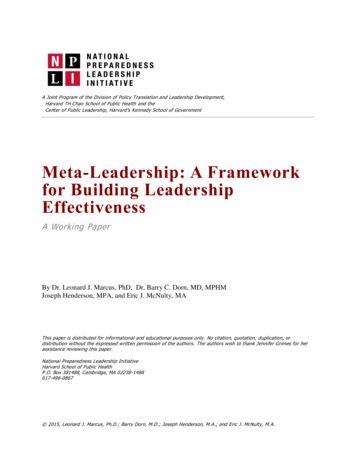
Transcription
12 Principles ofGreat LeadershipQuotes and Tips AboutLeadership Styles
12 Principles of Great Leadership:Quotes and Tips About Leadership StylesPg. 3 – IntroductionWhat Defines a Leader?Pg. 5 – Five Core Values of a Leader Integrity Authenticity People-First Excellence DisciplinePg. 10 – Seven Core Behaviors of a Leader Simplicity Creativity Bravery Beyond You Insight Vision CulturePg. 15 – SummaryPutting Your Leadership Style into Action
12 Principles of Great Leadership:Quotes and Tips About Leadership StylesIntroduction:What definesa leader?Experts have been researching and debating leadershipfor centuries. Since the beginning of time, there has been anatural need for individuals to take the reins and lead agroup of people from point A to point B.This doesn’t necessarily mean it is a largepilgrimage or massive undertaking, yet withany project, business plan, event, or activity,an individual or set of individuals must takeownership and provide guidance to assurethat everyone is heading in the samedirection and the project is brought to asuccessful completion.Even though this topic has been discussedfor years, the word “leadership” is oftenconfused with the word “management.” Inaddition, many people believe that the titleof leader is reserved for those with anameplate on their desk or a fancy title ontheir business card.You don’t need a titleto be a leader.Leadership is not reserved for those with a‘C’ in their title. Leaders can be found atmany levels in our communities,businesses, organizations, and in homesacross the world.On the other hand, a person can receive thetitle of manager based on an organization’sstructure; but not all managers are trueleaders. In contrast, true leadership can bedetermined, observed and measured byothers’ desire to follow you.We believe leaders should think andbehave differently; to strive to achievethe pinnacle of leadership; to becomeLeaders Worth Following.It is through this approach thatfollowers determine the designation ofleadership -- not an organizationalchart. With more than 10 years of researchin the field of leadership, Leadercast hasidentified 12 principles of leadership thatstand out among the greatest leadersworth following. These 12 principles can besummarized through five core values andseven core behaviors common amongleaders -- whether in business, ingovernment, on the sports field, acrosseducation, in non-profit organizations, andin the home. From around the world, theleaders in this report bring to life these keyprinciples and provide insightful, applicabletips to help you shape your leadershipstyle.“Manager” Does Not Equal “Leader”ManagerResponsible for people or projects 5 st4Excellence5DisciplinePossess honesty and uncompromising morals.Represent yourself in a genuine nature.Focus on individuals over numbers.Pursue surpassing ordinary standards.Exercise a commitment to a purpose.7 ring clarity to the complex.Foster an atmosphere that allowsothers to dream.Take a posture of unrelenting boldness.4Beyond You5Insight6VisionLeverage influence for the sake of others.Consistently do the wise thing – bringwisdom to every situation.Move toward a preferred future with littledeviation.LeaderInspires people to follow7CultureBe the architect of the conditions to win.To receive regular leadership content, visit www.leadercast.com and sign up for our free newsletter.3
12 Principles of Great Leadership:Quotes and Tips About Leadership Styles5 Leadership ValuesBefore adopting the behaviors of a leader, it's important to understand thecore values of a Leader Worth Following. These leaders have a foundation ofcommon values that consistently guide the way they act.Leadership Value #1:IntegrityPossess honesty anduncompromising morals.Gen. Hugh Shelton:Make Integritythe Cornerstone ofYour Leadership“If you don’t have integrity, then youdon’t have anything to build on.”– Gen. Hugh SheltonOne of the most foundational elements of leadership is personal integrity. Integrity is a set of values about which you would nevercompromise, no matter the circumstances. When leading, assuring that you have a strong handle on those values is critical to the basis oftrust and loyalty, and allows people to identify whether or not you are someone they want to follow.Similar to the way in which people decide to align themselves with brands such as Nike, Starbucks, Apple, or various other companies,people look for cues that allow them to identify with another individual who they would accept to extend their personal brand. Peoplemust first confirm that the uncompromising values you possess as a leader align with their own; only then can they determine whether ornot you will earn their time and trust.In his talk, “Make Integrity the Cornerstone of Your Leadership,” General Hugh Shelton tells a story about this cornerstone value ofleadership and the effects that it will have on your team.I happened to be in special operations command; it was my first four-star assignment. I had been working very hard all day long,getting “Death by PowerPoint,” as I call it. It was finally about 6:30 or 7 p.m. in the evening and I said, ‘I can’t take it anymore. I’mgoing home.’ So I take these two catalog briefcases full with slides and presentations that I’ve got to watch the next day and start outof the building toward home.But as I walk out of the building, there’s a thunderstorm. My driver, a young sergeant, has pulled the vehicle under the overhang. Hegets out, salutes me sharply and waits for me to get in. I said , ‘Pete, you know DoD regulations prohibit me from taking a government vehicle from home to work and vice versa.’ And with that I step off into the rain, carrying my two briefcases.The next day, I go back to work and about 10 a.m. the phone rings and Admiral Smith is on the line. So, I go pick up the phone. BeforeI can say a word he blurts out, ‘I hear you walked home in the rain last night and that you didn’t take the sedan’. I said, ‘That’s right,Ray, I didn’t take the sedan home because that’s against DoD regulations.’Already the word had spread to the West Coast that the General made the decision; that the General had done the right thing versusthe wrong thing. I often wonder what message that would have sent if I had taken the sedan.People watch leaders very carefully. You set the example and those you lead take cues from your actions and mirror similar behaviors.Possessing an unstaggering representation of integrity sets a critical foundation for your leadership.Leadership style tip: Be certain to hold true to your integrity in the good times and the bad.1) Do you value integrity more than anything else in your personal leadership? If not, which value is highest for you?2) What are the values upon which you absolutely would not compromise?To receive regular leadership content, visit www.leadercast.com and sign up for our free newsletter.4
12 Principles of Great Leadership:Quotes and Tips About Leadership StylesLeadership Value #2:AuthenticityRepresent yourself in agenuine nature.Patrick Lencioni:Trust – Leadingby Example“People will walk through fire for a leaderthat’s true and human.” – Patrick LencioniThe authentic leader is one who sets out to provide a genuine picture of who he/she is. Authentic leaders are not afraid to expose theirweaknesses or to be vulnerable in some of the toughest situations. Saying “I don’t know” is real. People respond more positively to aleader with whom they can identify as being human versus someone who appears too perfect.The behavior of authenticity results in people who are much more willing to follow you through thick and thin. It makes you moreapproachable and that usually results in having a more accurate picture of your team and state of the organization. In, “Trust – Leading byExample,” Patrick Lencioni highlights the actions of an authentic leader.The leader has to be the one that strips down and dives into that pool naked before anyone else will. It’s a leap of faith folks. Andit’s not comfortable. There’s that moment when we’re over our heads but we need to do it anyway. Now some people will say, ‘Pat,Pat, Pat, Pat, Pat what about that old saying: ‘Don’t let them see you sweat!’ You know something? People see us sweating beforewe realize we’re sweating. You know what the best leaders do? They’re the ones that go, ‘check this ooouuutt!’ pointing to theirsweaty armpit stains. That’s what we want, people who know themselves.The truth is, people will walk through fire for a leader who is true and human. They want to know that we know our humanity.Vulnerability on a team starts with authenticity with the team. It may be uncomfortable at times, but it is an important step to leading a strong team.Leadership style tip: Practice authenticity to set the tone for developing trust.1) When cultivating your team's authenticity, why is it so important for you to go first?2) List a recent example when you could have been vulnerable with your team (or a team member), but instead chose to play itsafe. What contributed to that decision? And, if you were in a similar situation in the future, how could you be more vulnerable?To receive regular leadership content, visit www.leadercast.com and sign up for our free newsletter.5
12 Principles of Great Leadership:Quotes and Tips About Leadership StylesBill McDermott:Don’t Forget toCelebrate theVictoriesLeadership Value #3:People-FirstFocus on individuals over numbers“In every case in business today, everyone is sobusy telling everybody what to do they forgot tolisten to what they’re supposed to do.”– Bill McDermottIn any industry, there is always a set of numbers that lets you know how you are doing. It could be revenue, test scores, wins, or any othermanifestation of a metric that allows the world to compare your organization to another. However, often a leader's path to pursue ametric can blind him/her to what is truly important. More often than not, distractions occur that lead one to believe that shortcuts or cutsin resources or service may be the answer to achieving the expected numbers. Yet, it takes a team of people to execute a plan. It isthese individuals who make the difference between the current state of an organization and the desired state. When you take the time tofocus on the individuals in your organization, you’ll usually not only find the answers you’re looking for to advance your cause, but mostlikely a key to driving long-lasting change.In “Don’t Forget to Celebrate the Victories,” Bill McDermott, CEO of SAP, talks about how focusing on the individuals allowed him to takean organization from last to first in under a year.I spent the first three weeks just listening and learning and asking people why are you #66 out of 66 operations? I didn’t come in witha preconceived vision or notion of what had to be done. What do you think I learned? They told me three things. Number one, theysaid, 'The guy before you just wanted to cut costs. Will you please give us back the water?' The second thing they said was, 'Give us aclear vision of what you want us to do.' People always just want to know what you want them to do and once they do know, they'llexecute the plan -- as long as it's a good, solid plan. And the third and the biggest thing was, 'Will you give us our holiday party back,please? Because we like to dance in Puerto Rico and we haven’t danced in a long time, and that holiday party is everything to us.'So, first meeting, we announced that we will hire Gilberto Santa Rosa, who was the number 1 salsa singer in Puerto Rico, to put on theannual holiday party. Then I said, ‘So, now that I’m on the hook for spending all this money on Gilberto, you’re on the hook for goingfrom #66 to first.’ That high level of expectation with an incredibly clear and simple plan, knowing full well that in the end, they willdance with Gilberto at the San Juan hotel in the most glorious setting possible, became the driving force of this underdog comingfrom behind to win the race.Every day you saw this downtrodden office with people who didn’t believe coming more and more to life. That year we went from 66to 30 by the middle of the year. By the fourth quarter of the year we were number five and by December we were number one. Thepeople, what it meant to their families, what it meant to job creation, what it meant to the customers, what it meant to the pride ofPuerto Rico, was so heartfelt and powerful that today it inspires me just to think of it.We are often moving so fast and focusing on what is expected of us that it can be easy to forget what it is that drives others to follow ourlead. Yet, focusing on individuals first and establishing a reward system that aligns with their interest can sometimes make all thedifference.Leadership style tip: Focus on the individuals you lead in order to drive the desired results.1) What questions are you asking your team to determine how you can make them more successful?2) When numbers are lower than expected, what is your typical reaction? How will that change now?To receive regular leadership content, visit www.leadercast.com and sign up for our free newsletter.6
12 Principles of Great Leadership:Quotes and Tips About Leadership StylesLeadership Value #4:ExcellencePursue surpassingordinary standards.Craig Groeshel:Build Powerful &Positive Habits – TheImportance ofStandards“There are certain disciplines that triggerother disciplines that can be life changing.”– Craig GroeshelOne of the biggest indicators used to determine the potential of a leader is his or her pursuit of excellence. This behavior not only tendsto be present during a leader's work day, but also in everything he/she does.Just watch the leaders you respect in a restaurant or on the street. They tend to be the ones who will straighten the sugar packets orpick up litter that someone else has dropped. It’s not because it is their resp
addition, many people believe that the title of leader is reserved for those with a nameplate on their desk or a fancy title on their business card. Leadership is not reserved for those with a ‘C’ in their title. Leaders can be found at many levels in our communities, businesses, organizations, and in homes across the world. On the other hand, a person can receive the title of manager .











